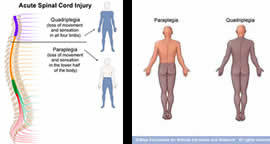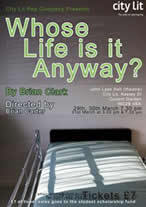
 What if a state legislature were to succeed in essentially obliging a woman to bring a life into being -- no matter how she became pregnant, no matter the complications and risks for her or the fetus?
What if a state legislature were to succeed in essentially obliging a woman to bring a life into being -- no matter how she became pregnant, no matter the complications and risks for her or the fetus?
The abortion analogy
If a state legislature were to succeed in thwarting (or even just limiting access to) abortions, might it feel politically emboldened to insist that someone suffering a wholly debilitating, degrading and irreversible medical circumstance must continue to live -- and "live" and "live," no matter that person's pain and despair; no matter that person's well-considered desire to have a dignified leave-taking.
Efforts by Texas (and other states) to limit a pregnant woman's decision-making and her access to pre-natal options, have been thwarted -- for now.
It was a mere fifty-one years ago that the U.S. Supreme Court overturned a Connecticut law that barred married women (married women!) from receiving information about contraception. That Connecticut law authorized the prosecution of women's health counselors as criminals.
"Pro-life" hardliners will never be swayed by legal briefs and court opinions - nor by the statutory examples of California, Oregon, Vermont, and Washington.
But, perhaps, possibly? -- maybe as to dire medical conditions? -- some few "pro-life" folks might have their stridencies softened, just a bit, by viewing a DVD, or two. Possible? Conceivable?
Here are my "cases" -- my suggested viewings:
 The Sea Inside (Mar Adentro)
The Sea Inside (Mar Adentro)
This 2004 dramatization depicts an actual years-long effort by a quadriplegic to get government approval (in Spain) for assisted suicide. It was acclaimed as the Best Foreign Language Film of the year by the Academy of Motion Picture Arts and Sciences. In addition to the Oscar, it won the Golden Globe as Best Foreign Language Film.
Diving into a familiar sea at a low tide rip-tide or undertow, Ramón Sampedro snapped his neck against the sea floor. At that youthful moment, he had been distracted by youthful thoughts. But he has had years and years (almost three decades) of incapacity to reflect and reconsider. He has never wavered.
I want to die because life for me in this condition has no dignity. I understand that other quadriplegics might get offended by what I say about not having any dignity. I don't judge anyone. Who am I to judge those who want to live. That's why I ask that neither me, nor the person who helps me die, be judged.
But there are judges to be convinced. Despite throngs of vocal supporters outside the courthouse (parading "Decriminalize Euthanasia Now" placards), and despite coolheaded advocacies to the bench, the judges are not moved.
Ever clear-headed, Ramón wonders if people who are shocked by his wish to die, somehow imagine that what he suffers and desires might be contagious. 
At their Galician farmhouse, he is well-attended by his nephew and lovingly-attended by his devoted sister-in-law. After decades of having his personal pleas ignored, his plight is championed by a right-to-die-with-dignity advocate and empathetic lawyers. After television interviews (based on actual TV appearances), he is visited by a stranger who is touched by his plight: The young woman first tries to talk him out of his death wish, and then...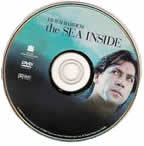 The sea gave him a full life, and then took it away
The sea gave him a full life, and then took it away
At the age of 19, Ramón went to sea, and through photos we see that he traveled the world and experienced the world quite fully. He explains, "Sailors travel the world for free."
 But with his freedom gone so completely, he asks anyone offering friendship to be his friend by respecting his wishes. And he "pens" his poetical pleas by using a drawing stick he designed, which allows him to compose and record his longings. Even with only restricted movements of mouth and chin, he forms letters on a scroll that he conceived and which his nephew and father constructed. These writings will become part of his legacy.
But with his freedom gone so completely, he asks anyone offering friendship to be his friend by respecting his wishes. And he "pens" his poetical pleas by using a drawing stick he designed, which allows him to compose and record his longings. Even with only restricted movements of mouth and chin, he forms letters on a scroll that he conceived and which his nephew and father constructed. These writings will become part of his legacy.

The debate -- ecclesiastical versus humanistic
A particularly energizing and entertaining scene has bed-ridden Ramón parrying a priest's arguments that are relayed up to him by the priest's young acolyte. The priest is also a quadriplegic. His wheelchair cannot be maneuvered up the narrow stairwell to Ramón's room. Up and down, up and down, the acolyte delivers the doctrine and returns with Ramón's calm rebuttals. Perspiring and short of breath, the acolyte's face suggests that he is not familiar with refutations to the priest's gospel.
Tilting at The Church and the judiciary
On his way to a courtroom, we are treated to scenic Spain and Ramón seems transfixed by the turning blades of a turbine wind-farm. Director and screenwriter Alejandro Amenábar must surely have wanted us to think of another Spaniard -- Don Quixote -- whose imagination and delusions did him in. Ramón tilts at provincial windmills, jousting with the clergy and the courts. 
But Ramón Sampedro is "serene and perfectly lucid" - his realities make him want to finish the job.
He may be dreaming "the impossible dream." Amenábar fashioned scenes in which Ramón flies out his bedroom window to soar above Galician-like landscapes, all the way to the sea. These flights are set to Puccini's "Nessun Dorma," which translates to "none shall sleep." The flights are moving in a number of ways. One is reminded of the Manhattan overflights of Alejandro Iñárritu's Birdman. The escape fantasies are much more than escapism.
There are "escape" plans in both Me Before You and in Whose Life Is It Anyway? However, in neither story do we see or read of the very final passage to passing.
By contrast, in The Sea Inside, with Javier Bardem delivering the words that were actually spoken by the long-suffering quadriplegic, we bear witness - figuratively, and quite literally - to the last straw. 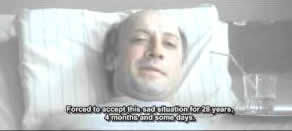
Whose Life Is It Anyway?
"You are now part of the optimism industry. Everyone who deals with me acts as though, for the first time in the history of medical science, a ruptured spinal column will heal itself - it's just a bit of a bore waiting for it to happen."
 In Brian Clark's play, sculptor Ken Harrison is essentially left with only the use of his brain, following "a roadway accident." After six months in the ER and intensive care units, he asks the chief physician at the hospital where he is "housed" for a prognosis:
In Brian Clark's play, sculptor Ken Harrison is essentially left with only the use of his brain, following "a roadway accident." After six months in the ER and intensive care units, he asks the chief physician at the hospital where he is "housed" for a prognosis:
KH:"I'm not asking you for a guarantee on oath. I am simply asking for your professional opinion. Do you believe I will ever walk again?
Dr. Emerson:"No."
KH:"Or recover the use of my arms?"
Dr. Emerson: "No."
KH:"Thank you... for your honesty."
The arguments for accepting "acceptance"
As a quadriplegic, sculptor Ken Harrison is nevertheless told, "It's surprising how we can come to accept things." In a following scene, the chief physician persists:
Dr. Emerson:"You will find that as you gain acceptance of the situation you will be able to find a new way of living."
Harrison counters that he has accepted the fact that his existence is not a life he chooses to live - and thus he wants to end his existence.
A social worker is assigned to acquaint Harrison with possibilities for a life using a special-designed reading machine and an adapted typewriter.
Declining to accept "acceptance"
Harrison, the former sculptor, counters:"How about an electronically-operated hammer and chisel? No? How about a cybernetic lump of clay?"
However wondrous the options, there's no device that would allow Harrison to think, imagine, and create through his hands.
"I have absolutely no desire at all to be the object of scientific virtuosity... I do not want to go on living with so much effort for so little result." 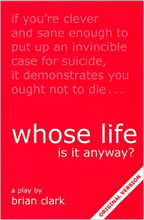
In 1978 on a London stage, in 1979 on a New York stage
With Tom Conti playing Harrison, playwright Brian Clark forced theatre-goers to witness and weigh the moral mandates of the hospital (preserve life -- whatever that life is and may be) against the immobile utterly-dependent patient's wishes not to be preserved.
Hospital heroics have brought Harrison back from death, but all those medical marvels cannot bring back the life he had so cherished. He does not want to continue to be relegated to "a fate worse than death."
To his lawyer: 'With all respect, I know that our hospitals are wonderful. I know that many people have succeeded in making good lives with appalling handicaps. I'm happy for them, and I respect and admire them. But each person must make their own decision. And mine is to die quietly and with as much dignity as I can muster -- and I need your help.'
Would a judge's judgment still be necessary today?
The hospital makes its case for compulsory commitment under a provision of the Mental Health Law that deals with those who are clinically depressed and thus unable to make rational decisions.
To the extent she can, Dr. Clare Scott tries to win over the hospital:
"But surely a wish to die is not necessarily a symptom of insanity? A man might want to die for perfectly sane reasons."
We read and hear of "the trap" -- "the Catch-22."
"If you're clever and sane enough to put up an invincible case for suicide, it demonstrates you ought not to die."
Harrison has sent away his girlfriend -- "to release her from a lifetime of sacrifice" and by way of holding on to some semblance of self-respect, some dignity.
"Dignity," he argues, "begins with choice." He had worked many years to achieve art in sculpture; he does not wish to be "a medical achievement."
Physical incapacity - and the legal incapacity to choose
"I can't do the things I want to do. I want it recognized that, for me, life is over.... as far as I'm concerned, I'm dead already.... I cannot accept that this condition constitutes life in any real sense at all.... Everything is geared just to keeping my brain active, with no real possibility of it ever being able to direct anything. As far as I can see, this is an act of deliberate cruelty."
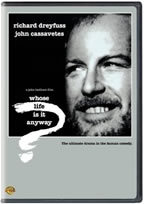
Stage to screen
The play was honored with the 1978 Laurence Olivier Award for Best New Play and with a Tony best play nomination in 1979. In the 1981 film adaptation, Brian Clark's screenplay and John Badham's direction gave Richard Dreyfuss opportunities to bring even more wit and considerable poignancy to the plight and the medical-moral point-counterpoint.
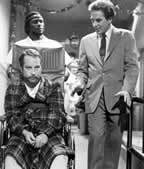 In the film, we get to see how Harrison sketched, and how he molded clay. We get to see his studio and his creations - all of which convey balletic movement.
In the film, we get to see how Harrison sketched, and how he molded clay. We get to see his studio and his creations - all of which convey balletic movement.
What sustained him, what enlivened him and what he lived for, was his sculpting. What inspired him was a love he cannot reciprocate in full.
Devising a case for release, and freedom
Harrison argues that the discharge he seeks is perfectly reasonable - and sane - given his particular circumstances.
Rather than try to prove that Harrison is merely manifesting a quite understandable "reactive depression," in contrast to "clinical depression," his lawyer makes the novel argument that it is unlawful to detain Harrison's "body" and that "the body" should be released under the doctrine of habeas corpus.
In the film, a Boston judge hears these arguments with the parties assembled in the hospital's small unprepossessing library. After consulting actual judicial decisions concerning "real life" people (actual bodies) that were hooked up to life-support machinery, the judge renders this analysis:
"A deliberate decision to embark on a course of action that will lead inevitably to death is not ipso facto evidence of insanity. If it were, society would have to reward many men with a dishonorable burial rather than a posthumous medal for gallantry."
The ruling frees Harrison: his body cannot be lawfully detained. 
Maneuvering "life" in a wheelchair
Louisa Clark, the life-enhancing presence in Jojo Moyes' Me Before You, tells us that "There are things you don't notice until you accompany someone in a wheelchair. One is how rubbish most pavements are, pockmarked with badly patched holes, or just plain uneven. Walking slowly next to Will as he wheeled himself along, I saw how every uneven slab caused him to jolt painfully, or how often he had to steer carefully around some potential obstacle.... The other thing is how inconsiderate most drivers are. They park up against the sloped cutouts on the sidewalks, or so close together that there is no way for a wheelchair to actually cross the road...."
 Were it not for Louisa's Internet investigations, I would not have known of the Online quad community and their chat-rooms, which provided her with so much courage, generosity, imagination, encouragement and support.
Were it not for Louisa's Internet investigations, I would not have known of the Online quad community and their chat-rooms, which provided her with so much courage, generosity, imagination, encouragement and support.
In the men's room of the multiplex where I saw Me Before You, I noticed a wheelchair protruding from the wheelchair-accessible stall. The wheelchair couldn't make it all the way through the supposedly-wide-enough stall doorway.
At the same multiplex, prior to the feature film, my view of humanity was coarsened by the insipid on-screen promos, violent video-game samplers, and previews of coming attractions that featured relentless brutality and inhumanity. The humor and decency of Me Before You provided antidotes.
Tragedy and necessity, the mothers of invention
With the help of his father and nephew, Ramón Sampedro, once a ship's mechanic and inventor-by-fate, designed (for farm-shed-fabrication) a mechanized wheelchair, a wheelchair-ramped car, an overhead cord-and-ring that allowed him to answer the phone by pulling on the cord with his teeth. His "drafting table" was a scroll he inscribed with the tooth-held stick-pencil he had conceived, as the rest of his body shriveled and atrophied.
A personal Brexit
With Traynor wealth and major-G Internet, Will Traynor was able to purchase a high-end adapted minivan equipped with a retractable ramp; voice-recognition software, bathing hoists and state-of-the-art hygiene aids, professional nursing care, the initially-awkward attentions of chatty upbeat Louisa Clark - and a dignified leave-taking not available in Great Britain.
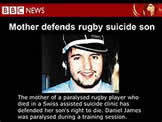 Will Traynor's plight - and desire for a self-determined exit - was not without real-life precedent. Parliamentary debate and inaction led an actual British family to their own Brexit. Without naming the family, Jojo Moyes wove that actual case into her story-telling. She has Nathan, Will Traynor's steady and ultra-competent nurse, provide Louisa with what may or may not serve as precedent - but which informs, and paves the way.
Will Traynor's plight - and desire for a self-determined exit - was not without real-life precedent. Parliamentary debate and inaction led an actual British family to their own Brexit. Without naming the family, Jojo Moyes wove that actual case into her story-telling. She has Nathan, Will Traynor's steady and ultra-competent nurse, provide Louisa with what may or may not serve as precedent - but which informs, and paves the way.
"He's not going to get better.... I can't judge what he wants to do. That's his choice.... I want him to live. Only if he wants to live."
To the extent literature and film can do so, The Sea Inside, Whose Life Is It Anyway?, and Me Before You place us (the willing among us) in the wheelchairs and beds of quadriplegics. We learn about their predicaments - we can almost feel their discomfort; we can begin to imagine their disinclinations and despair.
We learn that when so much freedom is gone - the freedom to choose becomes all the more precious. Shouldn't society allow for a final freedom - the liberty to be liberated from suffering, and undying uncertainty.
Spinal-cord diagram credits:
Mayo Clinic Foundation for Medical Education and Research
Johns Hopkins Medicine Health Library
